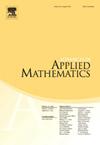四元词的MP-ratio的最优上界
IF 1.3
3区 数学
Q3 MATHEMATICS, APPLIED
引用次数: 0
摘要
所谓的mp比率是一种衡量给定单词“回文堆积”程度的方法。所有n元词集合的MP-ratio的下界(通常)是1,而在一般情况下,最佳可能上界是一个开放问题。对于n=2(其中最优上界是4)和n=3(其中最优上界是6),可以求解。此外,已知在n元情况下,最优边界在2n和增长阶数n2n2之间。在本文中,我们解决了四元词的这个问题,我们证明了MP-ratio的最佳可能上界等于8。我们相信这是最后一个结果为2n的案例,也就是说,我们相信对于n大于等于5的单词,其mp比率严格大于2n。本文章由计算机程序翻译,如有差异,请以英文原文为准。
The optimal upper bound on the MP-ratio for quaternary words
The so-called MP-ratio is a kind of measure of how “packed with palindromes” a given word is. The lower bound on the MP-ratio for the set of all n-ary words is (trivially) 1, while the best possible upper bound is an open problem in the general case. It is solved for (where the optimal upper bound is 4) and for (where the optimal upper bound is 6). Also, it is known that in the n-ary case the optimal bound is between 2n and the order of growth . In this article we solve this problem for quaternary words, for which we show that the best possible upper bound on the MP-ratio equals 8. We believe that this is the last case in which the result is 2n, that is, we believe that for there are words whose MP-ratio is strictly larger than 2n.
求助全文
通过发布文献求助,成功后即可免费获取论文全文。
去求助
来源期刊

Advances in Applied Mathematics
数学-应用数学
CiteScore
2.00
自引率
9.10%
发文量
88
审稿时长
85 days
期刊介绍:
Interdisciplinary in its coverage, Advances in Applied Mathematics is dedicated to the publication of original and survey articles on rigorous methods and results in applied mathematics. The journal features articles on discrete mathematics, discrete probability theory, theoretical statistics, mathematical biology and bioinformatics, applied commutative algebra and algebraic geometry, convexity theory, experimental mathematics, theoretical computer science, and other areas.
Emphasizing papers that represent a substantial mathematical advance in their field, the journal is an excellent source of current information for mathematicians, computer scientists, applied mathematicians, physicists, statisticians, and biologists. Over the past ten years, Advances in Applied Mathematics has published research papers written by many of the foremost mathematicians of our time.
 求助内容:
求助内容: 应助结果提醒方式:
应助结果提醒方式:


